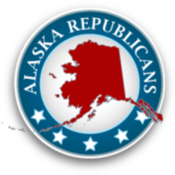It’s the 12 Days of Ballotpedia! Your gift powers the trusted, unbiased information voters need heading into 2026. Donate now!
Republican Party primaries in Alaska, 2018
- General election: Nov. 6
- Voter registration deadline: Oct. 7
- Early voting: Oct. 22 - Nov. 5
- Absentee voting deadline: Postmark Nov. 6
- Online registration: Yes
- Same-day registration: No
- Voter ID: Non-photo ID required
- Poll times: 7:00 a.m. to 8:00 p.m.
| Republican Party primaries, 2018 |
 |
| Primary Date |
| August 21, 2018 |
| Federal elections |
| Republican primaries for U.S. House |
| State elections |
| Republican primaries for Alaska legislature |
| Republican primary for governor |
| Republican primary for lieutenant governor |
| State party |
| Republican Party of Alaska |
| State political party revenue |
Primary elections—in which registered voters select a candidate whom they believe should run on the party's ticket in the general election—can reflect internal conflict over the direction of a party.
Heading into the 2018 election, the Republican Party's legislative record during Donald Trump’s presidency figured into several Republican primaries. This record included the passage of major tax legislation in December 2017 and the confirmation of federal judges. It also included a $1.3 trillion omnibus spending bill in March 2018, which Trump opposed, and unsuccessful efforts to repeal and replace the Affordable Care Act.[1][2]
Trump, himself, also played a role in Republican primaries. His approval rating reached 90% in June among self-described Republicans, according to a Gallup survey.[3] Many Republican candidates campaigned on their support for Trump, and negative ads accusing opponents of criticizing the president were common.[4][5][6] A May report found Trump's name or image had appeared in 37% of all Republican campaign ads at that point in 2018.[7]
This page focuses on the Republican primaries that took place in Alaska on August 21, 2018. In addition, the page provides context for understanding the state party apparatus.
Battleground primaries
Battleground elections are those that Ballotpedia expected would either be more competitive than other races or attract significant national attention.
Federal elections
U.S. House
- Don Young (Incumbent) ✔
- Thomas Nelson
- Jed Whittaker
State elections
Alaska Party Control: 1992-2025
No Democratic trifectas • Six years of Republican trifectas
Scroll left and right on the table below to view more years.
| Year | 92 | 93 | 94 | 95 | 96 | 97 | 98 | 99 | 00 | 01 | 02 | 03 | 04 | 05 | 06 | 07 | 08 | 09 | 10 | 11 | 12 | 13 | 14 | 15 | 16 | 17 | 18 | 19 | 20 | 21 | 22 | 23 | 24 | 25 |
|---|---|---|---|---|---|---|---|---|---|---|---|---|---|---|---|---|---|---|---|---|---|---|---|---|---|---|---|---|---|---|---|---|---|---|
| Governor | I | I | R | D | D | D | D | D | D | D | D | R | R | R | R | R | R | R | R | R | R | R | R | I | I | I | I | R | R | R | R | R | R | R |
| Senate | S | R | R | R | R | R | R | R | R | R | R | R | R | R | R | D | D | D | D | D | D | R | R | R | R | R | R | R | R | R | R | S | S | S |
| House | D | D | D | R | R | R | R | R | R | R | R | R | R | R | R | R | R | R | R | R | R | R | R | R | R | D | D | S | S | S | S | S | S | S |
Gubernatorial election
![]() Republican primary candidates
Republican primary candidates
Did not make the ballot:
Lieutenant gubernatorial election
![]() Republican primary candidates
Republican primary candidates
State legislative elections
Ballotpedia identified battleground races in the 2018 Alaska state legislative Republican primary elections. These primaries had the potential to be more competitive than other races and could have led to changes in the membership of the Republican caucus or had an impact on general election races.
To determine the Alaska state legislative Republican primary battleground races in 2018, Ballotpedia examined races that fit one or more of the three factors listed below:
- Identified by the media as a notable primary election.
- One or more of the candidates received a notable endorsement.
- The primary was known to be competitive based on past results or because it was a rematch of a primary that was competitive in the past.
House battleground races
This map shows the 2018 Alaska state House Republican primaries that we watched.
House District 9
Did the incumbent file to run for re-election?
| Yes. |
What made this a battleground race?
| George Rauscher (R) held this seat heading into the 2018 elections. He drew a primary challenge from former incumbent Jim Colver, who Rauscher defeated in the 2016 primaries. Colver was a member of the Musk Ox Coalition while he served in the legislature. His campaign was supported by the union-aligned political group Working Families for Alaska.[8] |
Republican primary election
Republican primary for Alaska House of Representatives District 9
Candidate | % | Votes | ||
| ✔ |  | George Rauscher | 49.4 | 1,533 |
 | Jim Colver | 29.8 | 923 | |
 | Pamela Goode | 20.8 | 645 | |
| Total votes: 3,101 | ||||
 = candidate completed the Ballotpedia Candidate Connection survey. = candidate completed the Ballotpedia Candidate Connection survey. | ||||
| If you are a candidate and would like to tell readers and voters more about why they should vote for you, complete the Ballotpedia Candidate Connection Survey. | ||||
Do you want a spreadsheet of this type of data? Contact our sales team. | ||||
House District 13
Did the incumbent file to run for re-election?
| No. |
What made this a battleground race?
| Former state Rep. Nancy Dahlstrom, Bill Cook, and Craig Christenson ran to replace incumbent Dan Saddler (R), who did not file for re-election. Dahlstrom's campaign was supported by the union-aligned political group Working Families for Alaska.[8] According to Suzanne Downing of Must Read Alaska, Dahlstrom "was known as a reliable union backer the last time she served in the House and is seen as a potential Musk Ox coalition member."[8] |
Republican primary election
Republican primary for Alaska House of Representatives District 13
Candidate | % | Votes | ||
| ✔ |  | Nancy Dahlstrom | 41.0 | 642 |
| Craig Christenson | 30.3 | 475 | ||
| Bill Cook | 28.7 | 450 | ||
| Total votes: 1,567 | ||||
 = candidate completed the Ballotpedia Candidate Connection survey. = candidate completed the Ballotpedia Candidate Connection survey. | ||||
| If you are a candidate and would like to tell readers and voters more about why they should vote for you, complete the Ballotpedia Candidate Connection Survey. | ||||
Do you want a spreadsheet of this type of data? Contact our sales team. | ||||
House District 14
Did the incumbent file to run for re-election?
| No. |
What made this a battleground race?
| Jamie Allard, Eugene Harnett, and Kelly Merrick ran to replace incumbent Lora Reinbold (R), who did not file for re-election. Merrick married Joey Merrick, the head of the union-aligned political group Working Families for Alaska.[8] Merrick received support from a number of union political funds and union officials, including Public Employees Local 71 and United Association Local 367.[8] |
Republican primary election
Republican primary for Alaska House of Representatives District 14
Candidate | % | Votes | ||
| ✔ |  | Kelly Merrick | 42.5 | 1,339 |
 | Jamie Allard | 36.4 | 1,148 | |
| Eugene Harnett | 21.1 | 664 | ||
| Total votes: 3,151 | ||||
 = candidate completed the Ballotpedia Candidate Connection survey. = candidate completed the Ballotpedia Candidate Connection survey. | ||||
| If you are a candidate and would like to tell readers and voters more about why they should vote for you, complete the Ballotpedia Candidate Connection Survey. | ||||
Do you want a spreadsheet of this type of data? Contact our sales team. | ||||
House District 15
Did the incumbent file to run for re-election?
| Yes. |
What made this a battleground race?
| Gabrielle LeDoux held this seat heading into the 2018 elections. She was one of three Republicans to leave their party and join the Democratic-led majority coalition after the 2016 elections. She filed for re-election and drew a primary challenge from former KTUU photographer Aaron Weaver.[9] |
Republican primary election
Republican primary for Alaska House of Representatives District 15
Candidate | % | Votes | ||
| ✔ |  | Gabrielle LeDoux | 57.4 | 456 |
 | Aaron Weaver | 42.6 | 339 | |
| Total votes: 795 | ||||
 = candidate completed the Ballotpedia Candidate Connection survey. = candidate completed the Ballotpedia Candidate Connection survey. | ||||
| If you are a candidate and would like to tell readers and voters more about why they should vote for you, complete the Ballotpedia Candidate Connection Survey. | ||||
Do you want a spreadsheet of this type of data? Contact our sales team. | ||||
House District 31
Did the incumbent file to run for re-election?
| Yes (running as a nonpartisan candidate) |
What made this a battleground race?
| Paul Seaton held this seat heading into the 2018 elections. He was one of three Republicans to leave their party and join the Democratic-led majority coalition after the 2016 elections.[10] After the Alaska Supreme Court ruled that independents could run in party primaries, Seaton filed for re-election as a nonpartisan candidate and chose to run in the Democratic primary.[11] No other Democrats filed to run, while Republicans John Cox (who unsuccessfully challenged Seaton in the 2016 primaries), Sarah Vance, and Hank Kroll filed to run. |
Republican primary election
Republican primary for Alaska House of Representatives District 31
Candidate | % | Votes | ||
| ✔ |  | Sarah Vance  | 44.6 | 1,222 |
 | John Cox | 40.9 | 1,122 | |
 | Hank Kroll | 14.5 | 398 | |
| Total votes: 2,742 | ||||
 = candidate completed the Ballotpedia Candidate Connection survey. = candidate completed the Ballotpedia Candidate Connection survey. | ||||
| If you are a candidate and would like to tell readers and voters more about why they should vote for you, complete the Ballotpedia Candidate Connection Survey. | ||||
Do you want a spreadsheet of this type of data? Contact our sales team. | ||||
House District 32
Did the incumbent file to run for re-election?
| Yes. |
What made this a battleground race?
| Louise B. Stutes held this seat heading into the 2018 elections. She was one of three Republicans to leave their party and join the Democratic-led majority coalition after the 2016 elections. She filed for re-election and drew a primary challenge from Rich Walker. He faced Stutes in the 2014 Republican primary and received 27.8 percent of the vote. Stutes received 43.4 percent and Carol Austerman (R) received 28.8 percent. |
Republican primary election
Republican primary for Alaska House of Representatives District 32
Candidate | % | Votes | ||
| ✔ |  | Louise Stutes | 54.9 | 959 |
 | Rich Walker | 45.1 | 788 | |
| Total votes: 1,747 | ||||
 = candidate completed the Ballotpedia Candidate Connection survey. = candidate completed the Ballotpedia Candidate Connection survey. | ||||
| If you are a candidate and would like to tell readers and voters more about why they should vote for you, complete the Ballotpedia Candidate Connection Survey. | ||||
Do you want a spreadsheet of this type of data? Contact our sales team. | ||||
State party overview
- See also: Republican Party of Alaska
State political party revenue
State political parties typically deposit revenue in separate state and federal accounts in order to comply with state and federal campaign finance laws. The following table displays the Republican Party of Alaska's revenue over a six-year period from 2011 to 2016. Revenue totals are broken down by account type and year. The data was compiled through publicly available state and federal campaign finance reports.
| Republican Party of Alaska revenue, 2011 to 2016[12][13] | |||
|---|---|---|---|
| Year | Federal account | State account(s) | Total |
| 2011 | $83,772.69 | --[14] | $83,772.69 |
| 2012 | $363,047.30 | $414,040.29 | $777,087.59 |
| 2013 | $76,223.42 | $215,469.62 | $291,693.04 |
| 2014 | $1,889,745.53 | $491,851.86 | $2,381,597.39 |
| 2015 | $222,147.64 | $154,986.78 | $377,134.42 |
| 2016 | $747,560.07 | $231,716.89 | $979,276.96 |
Alaska compared to other states
The Democratic Party and the Republican Party maintain state affiliates in all 50 states, the District of Columbia, and select U.S. territories. The following maps display total state political party revenue per capita for the Democratic and Republican state party affiliates from 2011 to 2016. The blue map displays Democratic state parties and the red map displays Republican state parties. Click on a state below to view the state party's revenue per capita totals:
Total Democratic and Republican state political party revenue per capita in the United States, 2011-2016
Primary election scheduling
Alaska was one of two states to hold a primary election on August 21, 2018.
Voter information
How the primary works
Alaska uses a top-four primary for congressional and state-level offices. Under Alaska's top-four primary system, all candidates for a given office run in a single primary election. The top four vote-getters, regardless of partisan affiliation, then advance to the general election.[15][16]
For information about which offices are nominated via primary election, see this article.
Poll times
In Alaska, polling places are open from 7:00 a.m. to 8:00 p.m. local time. Alaska is divided between the Alaska time zone and the Hawaii-Aleutian time zone. Anyone in line when the polls close must be allowed to vote.[17][18]
Registration requirements
- Check your voter registration status here.
To register to vote in Alaska, each applicant must be a citizen of the United States, a resident of Alaska, and at least 18 years of age or within 90 days of their 18th birthday. An individual convicted of a felony involving moral turpitude may not register to vote until their voting rights have been restored. If registered to vote in another state, applicants must be willing to cancel that registration to vote in Alaska. To vote in Alaska, registered voters must be at least 18 years old and have been a resident of the state and election district for at least 30 days.[19]
Prospective voters can register online, with a paper form, or in person at a Division of Elections Office or a voter registration agency.[20] The deadline to register or make changes to a registration is 30 days before an election.[21]
If submitting an application form by mail, fax, or email, the applicant must provide one of the following forms of identification either with his or her application or when voting for the first time:[21]
| “ |
|
” |
Automatic registration
- See also: Automatic voter registration
Alaska automatically registers eligible individuals to vote when they apply for a Permanent Fund Dividend, unless they opt out.[23]
Online registration
- See also: Online voter registration
Alaska has implemented an online voter registration system. Residents can register to vote by visiting this website.
Same-day registration
- See also: Same-day voter registration
Alaska allows same-day voter registration in presidential election years, but voters who do so can vote only for the offices of president and vice president.[24]
Residency requirements
Alaska law requires voters to be a "resident of the state and of the election district that you seek to vote in for at least 30 days before an election," according to the Alaska Division of Elections.[20]
According to the Division of Elections' website, "you are considered an Alaska resident if you reside in the state and intend to remain a resident or, if you temporarily leave the state, you have intention to return (Active military members, spouses or dependents are exempt from the intent to return requirement)."[19]
Verification of citizenship
Alaska does not require proof of citizenship for voter registration. An individual applying to register to vote must attest that they are a U.S. citizen under penalty of perjury.[21]
All 49 states with voter registration systems require applicants to declare that they are U.S. citizens in order to register to vote in state and federal elections, under penalty of perjury or other punishment.[25] Seven states — Alabama, Arizona, Georgia, Kansas, Louisiana, New Hampshire, and Wyoming — have laws requiring verification of citizenship at the time of voter registration, whether in effect or not. One state, Ohio, requires proof of citizenship only when registering to vote at a Bureau of Motor Vehicles facility. In three states — California, Maryland, and Vermont — at least one local jurisdiction allows noncitizens to vote in some local elections. Noncitizens registering to vote in those elections must complete a voter registration application provided by the local jurisdiction and are not eligible to register as state or federal voters.
Verifying your registration
The site My Voter Information, run by the Alaska Department of Elections, allows residents to check their voter registration status online.
Voter ID requirements
Alaska requires voters to present non-photo identification while voting.[26]
The following were accepted forms of identification as of November 2025. Click here for the list of acceptable identification included in state statute to ensure you have the most current information.[26]
| “ |
(a) Before being allowed to vote, each voter shall exhibit to an election official one form of identification, including
|
” |
To view Alaska law pertaining to voter identification, click here.
Early voting
Alaska permits early voting. Learn more by visiting this website.
Early voting permits citizens to cast ballots in person at a polling place prior to an election. In states that permit no-excuse early voting, a voter does not have to provide an excuse for being unable to vote on Election Day. States that allow voters to cast no-excuse absentee/mail-in ballots in person are counted as no-excuse early voting states.
Forty-seven states and the District of Columbia permit no-excuse early voting.
Absentee voting
All voters are eligible to vote absentee/by-mail in Alaska. There are no special eligibility requirements for voting absentee/by-mail.[27]
If a voter is already registered to vote, an absentee ballot application must be received by elections officials at least 10 days prior to the election. If a voter has not yet registered to vote, or needs to update voter registration information, an absentee/mail-in ballot application must be received at least 30 days before the election.[27]
Pivot Counties
- See also: Pivot Counties by state
Pivot Counties are counties that voted for Barack Obama (D) in 2008 and 2012 and for Donald Trump (R) in 2016. Altogether, the nation had 206 Pivot Counties, with most being concentrated in upper midwestern and northeastern states. No counties in Alaska are Pivot Counties.
In the 2016 presidential election, Donald Trump (R) won Alaska with 51.3 percent of the vote. Hillary Clinton (D) received 36.6 percent. Libertarian candidate Gary Johnson received 5.9 percent, which was his third-best showing in a state in 2016.[28] From when it gained statehood in 1959 to 2017, Alaska voted Republican in 14 out of 15 presidential elections. The only time it voted Democratic was in 1964 when President Lyndon Johnson (D) defeated Senator Barry Goldwater (R) with 61.1 percent of the national vote.[29] From 1960 to 2016, Alaska voted for the winning presidential candidate in 60 percent of presidential elections.
Presidential results by legislative district
The following table details results of the 2012 and 2016 presidential elections by state House districts in Alaska. Click [show] to expand the table. The "Obama," "Romney," "Clinton," and "Trump" columns describe the percent of the vote each presidential candidate received in the district. The "2012 Margin" and "2016 Margin" columns describe the margin of victory between the two presidential candidates in those years. The "Party Control" column notes which party held that seat heading into the 2018 general election. Data on the results of the 2012 and 2016 presidential elections broken down by state legislative districts was compiled by Daily Kos.[30][31]
| In 2012, Barack Obama (D) won 13 out of 40 state House districts in Alaska with an average margin of victory of 20.4 points. In 2016, Hillary Clinton (D) won 13 out of 40 state House districts in Alaska with an average margin of victory of 17.3 points. |
| In 2012, Mitt Romney (R) won 27 out of 40 state House districts in Alaska with an average margin of victory of 27.5 points. In 2016, Donald Trump (R) won 27 out of 40 state House districts in Alaska with an average margin of victory of 27.4 points. Trump won four districts controlled by Democrats heading into the 2018 elections. |
| 2016 presidential results by state House district | |||||||
|---|---|---|---|---|---|---|---|
| District | Obama | Romney | 2012 Margin | Clinton | Trump | 2016 Margin | Party Control |
| 1 | 43.1% | 53.0% | R+9.9 | 40.2% | 49.5% | R+9.4 | D |
| 2 | 35.1% | 61.6% | R+26.5 | 29.9% | 59.9% | R+30.1 | R |
| 3 | 21.9% | 74.9% | R+53 | 16.8% | 73.1% | R+56.2 | R |
| 4 | 48.1% | 47.0% | D+1.1 | 45.4% | 44.3% | D+1.1 | D |
| 5 | 42.0% | 53.7% | R+11.7 | 41.7% | 48.1% | R+6.4 | D |
| 6 | 34.6% | 61.3% | R+26.6 | 30.9% | 59.9% | R+29 | R |
| 7 | 22.6% | 74.3% | R+51.7 | 18.7% | 73.2% | R+54.6 | R |
| 8 | 21.5% | 75.3% | R+53.8 | 15.4% | 77.3% | R+61.9 | R |
| 9 | 28.0% | 68.3% | R+40.3 | 21.2% | 69.8% | R+48.7 | R |
| 10 | 26.2% | 70.1% | R+43.9 | 20.5% | 70.9% | R+50.4 | R |
| 11 | 25.9% | 70.8% | R+44.8 | 22.8% | 68.6% | R+45.7 | R |
| 12 | 25.3% | 71.9% | R+46.6 | 20.8% | 71.2% | R+50.4 | R |
| 13 | 30.3% | 66.6% | R+36.2 | 26.6% | 63.5% | R+36.9 | R |
| 14 | 30.5% | 67.0% | R+36.5 | 30.4% | 59.5% | R+29.2 | R |
| 15 | 42.6% | 54.5% | R+11.9 | 37.8% | 52.0% | R+14.3 | R |
| 16 | 47.7% | 49.3% | R+1.6 | 45.7% | 44.4% | D+1.4 | D |
| 17 | 51.3% | 44.9% | D+6.4 | 50.1% | 39.8% | D+10.3 | D |
| 18 | 56.4% | 40.4% | D+16 | 54.2% | 37.2% | D+17.1 | D |
| 19 | 62.8% | 34.0% | D+28.9 | 56.8% | 34.8% | D+22.1 | D |
| 20 | 61.9% | 34.5% | D+27.4 | 59.9% | 31.5% | D+28.4 | D |
| 21 | 50.2% | 46.9% | D+3.3 | 50.1% | 41.2% | D+8.9 | D |
| 22 | 39.1% | 57.7% | R+18.6 | 40.3% | 51.7% | R+11.4 | I |
| 23 | 44.0% | 53.0% | R+9 | 42.8% | 47.9% | R+5.1 | D |
| 24 | 37.7% | 59.9% | R+22.2 | 39.6% | 52.0% | R+12.4 | R |
| 25 | 43.2% | 54.0% | R+10.8 | 42.6% | 48.1% | R+5.4 | R |
| 26 | 38.1% | 59.3% | R+21.2 | 39.0% | 52.5% | R+13.5 | R |
| 27 | 43.6% | 53.3% | R+9.7 | 43.7% | 47.8% | R+4.1 | R |
| 28 | 41.5% | 55.9% | R+14.4 | 42.8% | 48.8% | R+6 | R |
| 29 | 26.2% | 70.4% | R+44.2 | 23.0% | 69.2% | R+46.3 | R |
| 30 | 24.3% | 72.8% | R+48.5 | 20.8% | 70.7% | R+49.9 | R |
| 31 | 37.5% | 58.8% | R+21.2 | 34.8% | 56.3% | R+21.5 | R |
| 32 | 41.6% | 54.9% | R+13.4 | 37.1% | 51.6% | R+14.5 | R |
| 33 | 63.2% | 31.9% | D+31.3 | 61.9% | 28.2% | D+33.7 | D |
| 34 | 50.5% | 45.7% | D+4.8 | 46.1% | 43.1% | D+3 | D |
| 35 | 51.0% | 44.7% | D+6.4 | 42.7% | 46.6% | R+4 | D |
| 36 | 41.0% | 54.4% | R+13.5 | 33.5% | 55.3% | R+21.8 | I |
| 37 | 55.8% | 40.6% | D+15.2 | 49.4% | 39.5% | D+9.9 | D |
| 38 | 72.1% | 23.4% | D+48.7 | 57.7% | 23.9% | D+33.8 | D |
| 39 | 69.1% | 26.1% | D+42.9 | 59.7% | 26.7% | D+33.1 | D |
| 40 | 64.8% | 31.8% | D+33.1 | 54.1% | 31.8% | D+22.3 | D |
| Total | 41.2% | 55.3% | R+14.1 | 37.6% | 52.8% | R+15.2 | - |
| Source: Daily Kos | |||||||
See also
| Federal primaries in Alaska | State primaries in Alaska | Alaska state party apparatus | Alaska voter information |
|---|---|---|---|
Footnotes
- ↑ ‘’National Review’’, “Trump Is Not Blameless in the Spending-Bill Disaster,” March 28, 2018
- ↑ The New York Times, "A New Guide to the Republican Herd," August 26, 2012
- ↑ Gallup, "Trump Job Approval Slips Back to 41%," June 25, 2018
- ↑ Daily Commercial, "Trump hurdle looms large in Florida GOP governor primary," July 30, 2018
- ↑ Daily Commercial, "These 2018 Primaries Are Worth Watching," July 25, 2018
- ↑ Washington Post, "Republican primary candidates have one goal: Securing Trump’s endorsement or denying it to an opponent," July 25, 2018
- ↑ USA Today, "Donald Trump once divided Republicans; ads for midterms signal that's no longer true," May 17, 2018
- ↑ 8.0 8.1 8.2 8.3 8.4 Must Read Alaska, "Shocker: Unions playing big in five key Republican primaries," August 7, 2018
- ↑ Must Read Alaska, November 28, 2017
- ↑ KBBI, "Republican Party has a contender to run against Rep. Paul Seaton," February 14, 2018
- ↑ name=seatonAlaska Public Media, "Seaton files to run as independent in Democratic primary," June 1, 2018
- ↑ Alaska Public Offices Commission, "Search Reports," accessed May 2016 (Search terms Alaska Republican Party and Alaska Democratic Party)
- ↑ Federal Election Commission, "Candidate and Committee Viewer," accessed May 2016 (Search terms Alaska Republican Party and Alaska Democratic Party)
- ↑ Complete financial report is unavailable for this period.
- ↑ Alaska Division of Elections, "August 18, 2020 Primary Election Information," accessed November 25, 2025
- ↑ The Alaska Legislature, "Alaska Stat. § 15.25.010," accessed November 25, 2025
- ↑ Alaska Division of Elections, "Polling Place Hours," accessed November 24, 2025
- ↑ The Alaska Legislature, "Alaska Stat. § 15.15.320," accessed November 24, 2025
- ↑ 19.0 19.1 Alaska Division of Elections, "Who Can Register And Who Can Vote?" accessed November 24, 2025
- ↑ 20.0 20.1 Alaska Division of Elections, "Voter Registration," accessed November 24, 2025
- ↑ 21.0 21.1 21.2 Alaska Division of Elections, "State of Alaska Voter Registration Application," accessed November 24, 2025
- ↑ 22.0 22.1 Note: This text is quoted verbatim from the original source. Any inconsistencies are attributable to the original source.
- ↑ Alaska Department of Revenue, “Automatic voter registration,” accessed November 24, 2025
- ↑ Alaska Division of Elections, "Presidential Elections," accessed November 24, 2025
- ↑ Under federal law, the national mail voter registration application (a version of which is in use in all states with voter registration systems) requires applicants to indicate that they are U.S. citizens in order to complete an application to vote in state or federal elections, but does not require voters to provide documentary proof of citizenship. According to the U.S. Department of Justice, the application "may require only the minimum amount of information necessary to prevent duplicate voter registrations and permit State officials both to determine the eligibility of the applicant to vote and to administer the voting process."
- ↑ 26.0 26.1 The Alaska Legislature, "Alaska Stat. § 15.15.225," accessed November 25, 2025
- ↑ 27.0 27.1 Alaska Division of Elections, “Absentee and Early Voting,” accessed November 24, 2025
- ↑ Atlas of U.S. Presidential Elections, "2016 Presidential General Election Data - National," accessed May 31, 2017
- ↑ 270towin.com, "Historical Presidential Elections," accessed May 31, 2017
- ↑ Daily Kos, "Daily Kos Elections' statewide election results by congressional and legislative districts," July 9, 2013
- ↑ Daily Kos, "Daily Kos Elections' 2016 presidential results for congressional and legislative districts," February 6, 2017








